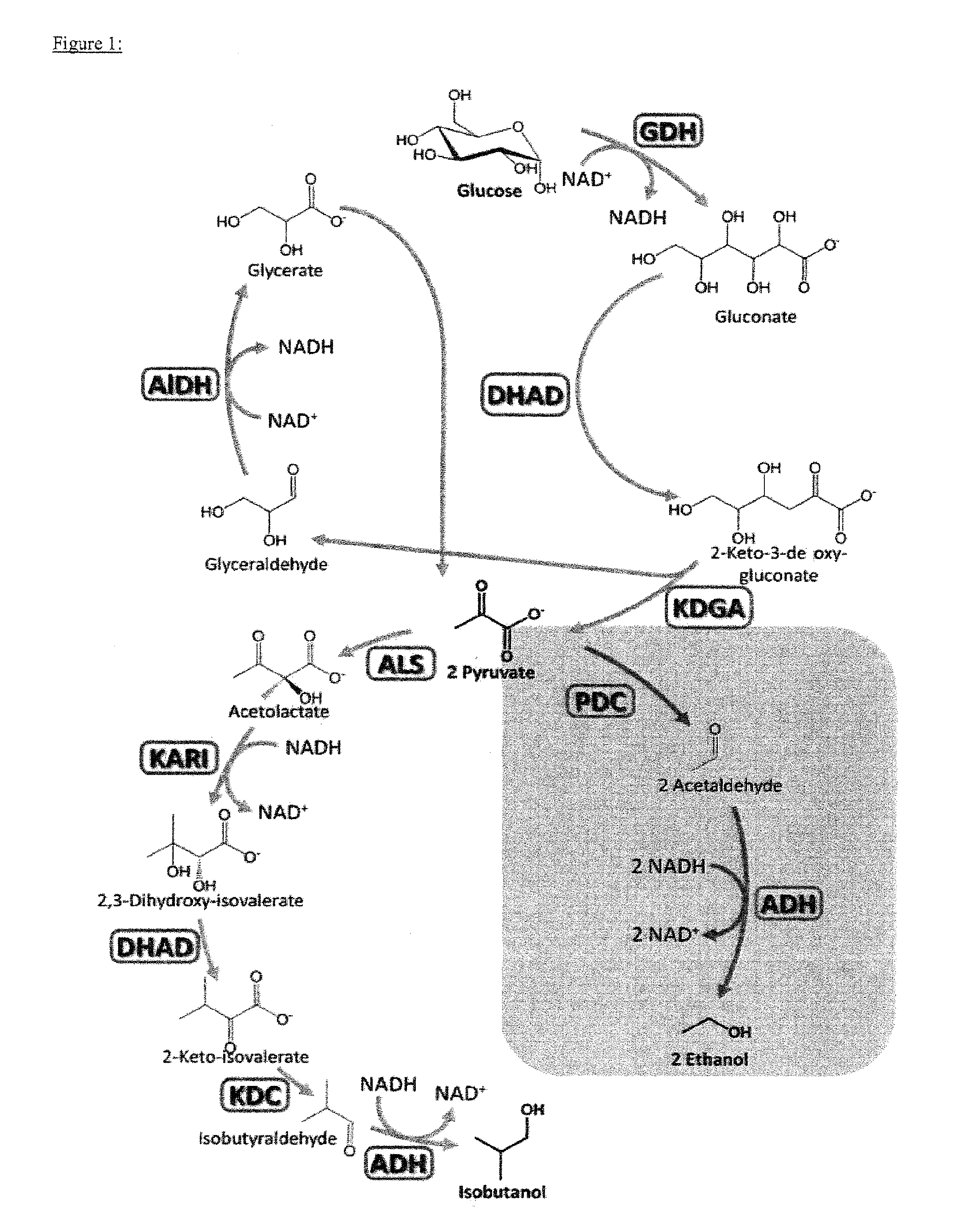Cell-free and minimized metabolic reaction cascades for the production of chemicals
a metabolic reaction and cell-free technology, applied in the direction of lyases, carbon-carbon lyases, transferases, etc., can solve the problems of unintended substrate redirection into non-productive pathways, low conversion efficiency and yield, and the physiological limits of cellular production systems. achieve the effect of enhancing thermostability, and reducing the number of reactions
- Summary
- Abstract
- Description
- Claims
- Application Information
AI Technical Summary
Benefits of technology
Problems solved by technology
Method used
Image
Examples
example 1
Ethanol Synthesis
[0276]One general example of the feasibility of the cell-free synthesis toolbox, glucose or galactose was converted to pyruvate using the enzyme cascade of conversion of glucose or galactose to pyruvate with four enzymes, comprising glucose dehydrogenase (GDH), gluconate / glycerate / dihydroxyacid dehydratase (DHAD), 2-keto-3-deoxygluconate aldolase (KDGA) and glyceraldehyde dehydrogenase (ALDH). The ALDH used in this example is defined by SEQ ID NO 10 as established in Example 4.
[0277]In a subsequent two-step reaction pyruvate was converted to acetaldehyde and then to ethanol by action of pyruvate decarboxylase (PDC) (J. Mol. Catal. B-Enzym. 2009, 61, 30-35) and alcohol dehydrogenase (ADH) (Protein Eng. 1998, 11, 925-930). The PDC from Zymomonas mobilis was selected due to its relatively high thermal tolerance and activity. Despite its mesophilic origin, Z. m. PDC is thermostable up to 50° C. (see table 10) which is in accord with the temperature range of more thermos...
example 2
Isobutanol Synthesis
[0279]This example demonstrates the successful conversion of pyruvate to isobutanol using only four additional enzymes (see FIG. 2, Table 2) in a completely cell-free environment. Initially, two pyruvate molecules are joined by acetolactate synthase (ALS) (FEMS Microbial. Lett. 2007, 272, 30-34) to yield acetolactate, which is further converted by ketolacid reductoisomerase (KARI) (Accounts Chem. Res. 2001, 34, 399-408) resulting in the natural DHAD substrate dihydroxyisovalerate. DHAD then converts dihydroxyisovalerate into 2-ketoisovalerate.
TABLE 2Enzymes used in the cell-free synthesis of isobutanol. Activitya, 50° C.Half-life, 50° C.T-OptimumEnzymeECSource organism(U / mg)(h)(° C.)E50 (% v / v)I50 (% v / v)GDH1.1.1.47S. solfataricus / 15>247030 (45° C.)9 (45° C.)Seq ID 02DHAD4.2.1.39S. solfataricus / 0.66, 0.011, 0.38177015 (50° C.)4 (50° C.)Seq ID 04KDGA4.2.1.14S. acidocaldarius / 4>2499[1]15 (60° C.)>12 (60° C.)bSeq ID 06ALDH1.2.1.3T. acidophilumc / 11263[2]13 (60° C.)3 ...
example 3
Solvent Tolerance
[0283]A key characteristic of cell-free systems is their pronounced tolerance against higher alcohols. To evaluate solvent tolerance of the artificial enzyme cascade, glucose conversion to ethanol was conducted as in Example 1 in the presence of increasing isobutanol concentrations (FIG. 4).
[0284]In contrast to microbial cells, where minor isobutanol concentrations (ca. 1% v / v) already result in loss of productivity, presumably through loss of membrane integrity, cell-free ethanol productivity and reaction kinetics were not significantly affected by isobutanol concentrations up to 4% (v / v). Only in the presence of 6% (v / v) isobutanol, ethanol productivity rapidly declined (1.4 mM ethanol in 8 h). This demonstrates that cell-free processes have the potential to tolerate much higher solvent concentrations than equivalent whole-cell systems. Based on the current data ALDH has the lowest solvent tolerance, as 3% (v / v) isobutanol already induce adverse effects on activit...
PUM
| Property | Measurement | Unit |
|---|---|---|
| temperature | aaaaa | aaaaa |
| temperature | aaaaa | aaaaa |
| volume | aaaaa | aaaaa |
Abstract
Description
Claims
Application Information
 Login to View More
Login to View More - R&D
- Intellectual Property
- Life Sciences
- Materials
- Tech Scout
- Unparalleled Data Quality
- Higher Quality Content
- 60% Fewer Hallucinations
Browse by: Latest US Patents, China's latest patents, Technical Efficacy Thesaurus, Application Domain, Technology Topic, Popular Technical Reports.
© 2025 PatSnap. All rights reserved.Legal|Privacy policy|Modern Slavery Act Transparency Statement|Sitemap|About US| Contact US: help@patsnap.com



